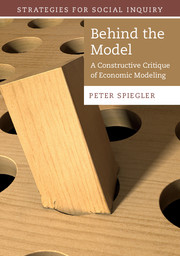5 - The financial crisis and economics
from Part II - The critique applied
Published online by Cambridge University Press: 05 December 2015
Summary
One of the central implications of the critique presented in Chapters 2 and 3 is that mathematical modeling, even at its best, is an inherently incomplete means of investigating social phenomena. Mathematical models (both theoretical and empirical) must presume that certain mathematical properties can inhere in the particular target system under study. But the plausibility of this presumption can only be evaluated in a non-question-begging way using methods that do not themselves rely on the presumption – it cannot be evaluated by mathematical methods alone. Failure to perform such an evaluation (or, worse, failure even to recognize the need for it) leaves one susceptible to the possibility that one's model is incapable of functioning as an apt representation of the target regardless of how well it may perform in mathematical analyses. Put another way, mathematical modeling on its own leaves us blind to the possibility that the target is organized in ways, and is subject to dynamics, that are essentially different from what the modeling exercise requires. In order to guard against this possibility, we need to supplement mathematical models with methods of investigation of the target that cast a wider net – specifically, methods that allow us to be sensitive to information that would indicate such essentially different configurational and dynamic possibilities.
In this chapter, I will apply these insights of the critique to the case of economic research in the years surrounding the financial crisis. In particular, I will argue that the kind of built-in blindness to relevant information discussed in Chapters 2 and 3 played a crucial role in the failure of economists to foresee the crisis, and that the post-crisis debate within the discipline about the implications of the crisis suggests that only minimal methodological reform is likely to take place. The chapter will proceed as follows. Section 5.1 will explore recent criticisms of the performance of Dynamic Stochastic General Equilibrium modeling in the lead-up to the crisis. Section 5.2 will examine the pre-crisis mainstream economics literature more broadly as well as the coverage of the precursors to the crisis in the financial press. Section 5.3 will examine the post-crisis debate.
- Type
- Chapter
- Information
- Behind the ModelA Constructive Critique of Economic Modeling, pp. 119 - 142Publisher: Cambridge University PressPrint publication year: 2015



